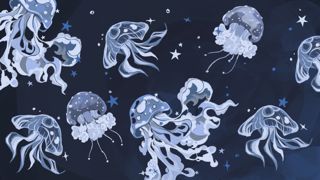
From the Sea to the Stars: Jellyfish in Space
- 20th Jun 2024
- Author: Diyura Sasitharan
Did you know that humans are more like jellyfish than we initially thought? Scientists, sparking with fascination for space exploration were eager to know how exactly micro-gravity would affect our development if we underwent long-term space travel. Could we potentially have space-born baby astronauts? Well, since we can’t send human babies up to space for our experiments, the scientists did the next best thing and sent some cosmic drifters on an interstellar adventure. Here is how space jellies uncovered the secrets about space exploration!
Jellyfish aren't really.... Fish
Jellyfish are aquatic sea creatures that tend to be characterised by their umbrella shaped bell and flowing tentacles, with their name referencing the jelly-like material they are made out of. Contradictory to their name, these ocean drifters aren’t actually fish - they are classed as invertebrates as they do not have a backbone!
Jellyfish have no brain, heart, bones or eyes, they truly are endlessly intriguing creatures! In this blog, however, we will specifically be talking about moon jellyfish, otherwise known as Aurelia Labiata.
Why send these ocean-drifters all the way to space?
The moon jellies that were sent to space had been tasked with a mission to improve our understanding of the effects of microgravity. It is very difficult to predict specifically how human bodies will react in a weightless environment.
But worry not, the jellyfish are here to tell us instead! Jellyfish are amongst the simplest organisms to exist here on Earth yet, interestingly, they actually possess neurons that share close similarities to the nerve cells that humans possess.
We, humans, have gravity receptors that are made up of calcium carbonate located in our inner ears. These structures can sense linear acceleration and are used as gravity, balance, movement and directional indicators. We call this structure an otolith.
Similar to this, Jellyfish use structures called rhopalia to maintain their correct orientation in the water. The rhopalia consists of calcium sulphate crystals, located at the base of their mushroom shaped bodies. These calcium sulphate crystals that are found in jellyfish are referred to as the statolith, which is analogous to the otolith found in mammals!
From 'baby' jellyfish to ' juvenile' jellyfish
Since the gravity up in space can get very sparse, this means that astronauts often have to deal with very intense motion sickness. It is vital to combat space sickness as it can be incredibly dangerous to the safety of our space-explorers. One of the effects of space sickness is reduced productivity, this can lead to mission delays and even further result in financial implications. Space travel can already get very expensive, added costs on top of that is definitely not something we want! This is why scientists argue that it is very important to study how gravity affects life, particularly the development of human life.
It would be quite difficult to study human babies in space as they would take many years to develop; this could lead to higher costs and maintenance (not to mention all the ethical issues that would be involved!). On the other hand, jellyfish that are in their polyp stage (still attached coastal reefs) take only six to eight days to develop into an ephyra (where they can swim free), hence it takes only five days for them to develop their gravity sensing organ. We can study many different phases of jellyfish due to the short time it takes for
them to develop.
Since jellyfish happen to share similar gravity-sensing structures to humans and develop at a faster rate, scientists thought to study these astronaut-turned moon jellies so that we can fight the effects of space sickness! This could give us valuable insights into how future generations of humanity would develop in response to growing up in a microgravity environment.
So how did the experiment work?
The jellyfish were launched on the rocket STS-40, in the Space Life Science-1 (SLS-1) on June 5th 1991. The experiment was led by a researcher named Dorothy Spangenberg and lasted nine days. One of the purposes of this mission was to investigate the consequences of the body’s adaptation to microgravity and readjustment to Earth’s gravity.
The jellyfish were split into two groups: one group were encouraged to develop their gravity sensors in space and the other on Earth. Both these groups were then compared with ground-based controls. In total, 2478 moon jellyfish, that were in their young polyp stages, had been sent to space in containers of artificial seawater. Researchers were able to encourage jellyfish to advance to their next stage of development (ephyra) through injecting iodine into the bags of seawater - this is when the rhopalia, which help maintain proper orientation, are developed.
What secrets did we uncover about space exploration?
By the end of the study, NASA had 60,000 jellyfish in space! The main discovery that scientists found was that space-born jellyfish had more difficulty swimming once they returned back to Earth. Upon their return back home, six times more ephyrae, which had developed in space, exhibited pulsing abnormalities compared to those developed on Earth. Scientists essentially concluded that the jellyfish had an extreme case of vertigo (where you tend to feel very dizzy). This result indicated that, although the sensory crystals had formed correctly in space, the jellyfish’s nervous system had adapted too well to microgravity and hence were unable to readjust to the 1g environment upon their return to Earth. This possibly could imply that
space-born human babies may find it difficult to properly orient themselves when back on Earth!
Full references / credits:
(Banner) Jellyfish. Credit: © Diyura Sasitharan
(1) Jellyfish at The Deep in Hull. Credit: Unsplash (https://unsplash.com/photos/macro-shot-of-jellyfish-jEqyV_rumuU)
(2) From polyp to ephyra. Credit: Hana Janoušková CC BY-SA 4.0 (https://commons.wikimedia.org/wiki/File:Cnidaria-life-cycle.svg)
(3) Jellyfish under the sea. Credit: Unsplash (https://unsplash.com/photos/jelly-fish-under-the-sea-tBnLsg_VDJw)
(4) Jellyfish. Credit: © Emma Mosley





